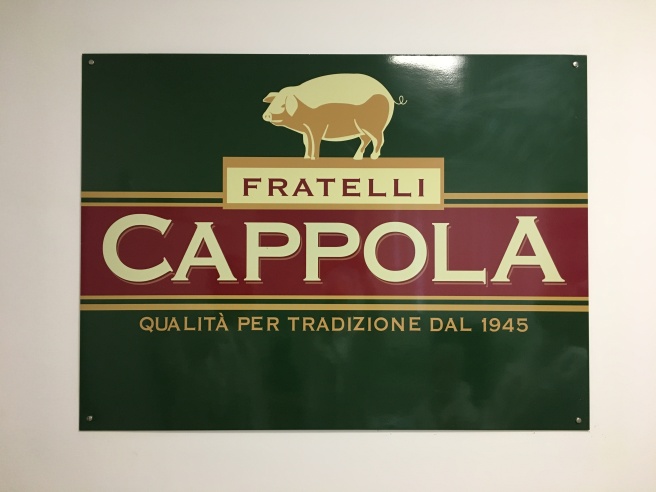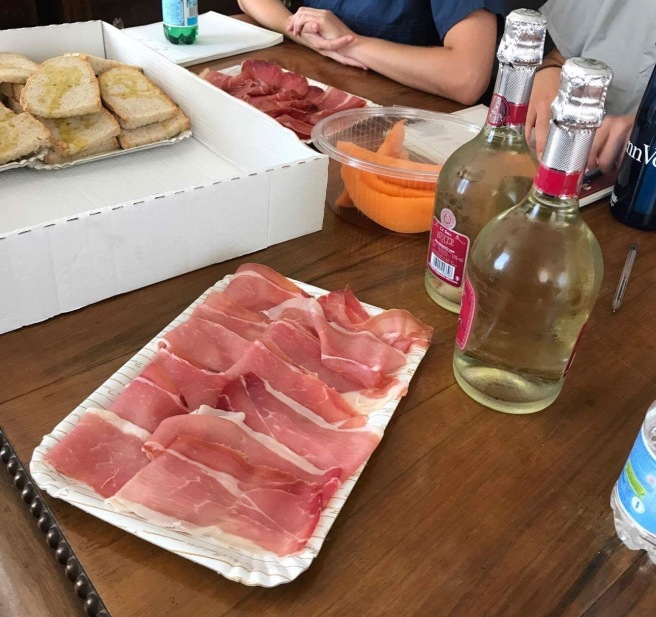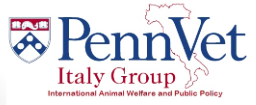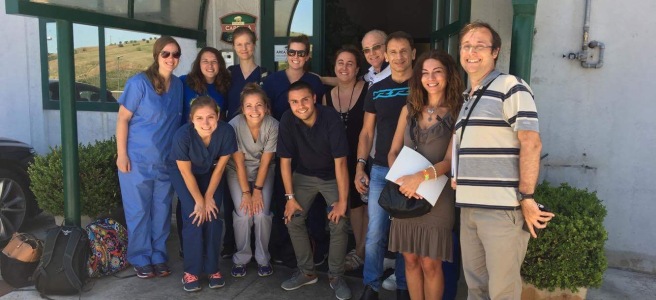Buongiorno!
Today we had a 6am departure time to spend the morning in Pescara at Cappola Brothers, a family-owned business that produces raw and cooked hams, cured meat, and other types of meat cuts. They follow the production process from slaughter through creation of the final product. Our time spent here was to observe and evaluate the welfare of pigs throughout the production process.
Cappola Brothers, which began in the 1940’s, has been passed down through several generations and is currently owned by three cousins. They are very proud of their family business, as they should be. The pigs they source for production come only from Italy, which is great in terms of welfare (more on that in a bit!). Typically the pigs used for production are between 146-176 kilograms (approximately 321-387 lbs), which is necessary to be certified by Parma. Parma is known for its prosciutto, or cured ham. Additional requirements for Parma certification include being sourced from farms within specific regions of central and northern Italy and being one of three breeds. A ham that meets the requirements will be fire-stamped with the Parma seal of approval. Cappola prides themselves on their high quality meat, a direct result of proper welfare for production pigs.

The European Union has a law, EC 1099/2009 that sets regulations for animal welfare for animals when they are on the farm, during transport, and at the slaughterhouse. These specifications must be implemented and owners have to be able to prove compliance; inspections and audits at EU, regional, and local levels help ensure this. Additionally, there is a requirement for facilities to have an external expert for welfare in addition to an internal animal welfare expert if they slaughter more than a certain number of animals. This individual must be present during the process to ensure proper welfare and treatment.
We met with a veterinarian from the Local Health Unit in Pescara and one of the owners to tour the facility. It is separated into three areas categorized as “dirty,” “capture,” and “clean”. In order to maintain cleanliness and prevent cross-contamination we went backwards from the “clean” side to the “dirty” side. The “clean” side contains all of the fresh cut meat, which is then transported to refrigerators at 0-2 Celsius (about 32 Fahrenheit) to ensure food safety. The “capture” part of the plant involves workers cutting the meat into specific cuts to be sold. Finally, the “dirty” part is the area where pigs are unloaded and held until slaughter.
Both men explained to us the importance of animal welfare within the context of the animal as well as the quality of the meat. Pigs that are stressed at the time of slaughter have a lower quality of meat due to release of cortisol, and those that are mistreated will be bruised and their meat will be of no value. Good welfare practices have been integrated into the design of the slaughterhouse as well as the production process:
- Pigs are only sourced from Italy to minimize transport time
- The ramp from the truck to the holding pens is put at an even level with it to help reduce slipping
- Holding pens are large enough for all pigs to stand or lay down, and are equipped with drinkers and mist showers when it gets hot in the summer
- Pigs are kept in groups from the same farm for familiarity and to help prevent fighting
- Floors in holding areas are grooved to help prevent slipping and/or falling
- Any ramps needed are used at an angle of 50 degrees or less to make it easier for the pigs
From a management perspective there are also good welfare practices implemented:
- A certified animal health officer must be present at the facility
- There is an external animal welfare expert present, as required by law
- Any employee physically working with pigs must receive training in animal welfare and become certified
They also have implemented several standard operating procedures as well as closed circuit monitoring systems voluntarily to monitor animal welfare during the entire process.
After our tour and a lecture on Assessing Animal Welfare at a Slaughterhouse, the Cappola brothers treated us to some of their own prosciutto and salami, accompanied by melon and fresh bread! I’m so glad I had the opportunity to visit and learn about something that I feel people in general are very far removed from. This is something I may not have had the chance to do otherwise and I truly believe it has bettered me both as a future clinician and a consumer.

After a nap on the car ride back, we spent some time during the afternoon at a Cat Museum (a dream come true for me) that opened this past December in Teramo. The entire collection belongs to one man, Paolo Gaotbacurta, who donated it so the museum could be started. It was truly fascinating to see all of the objects he has, from sculptures and paintings to pillows and clocks. Tonight we’re off to enjoy some local cuisine with some of our educators from IZSAM!
Ciao!
Steph




